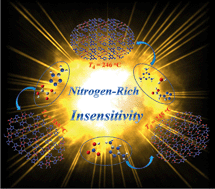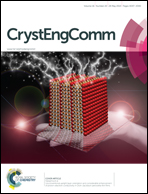Intermolecular interaction influenced energy and sensitivity of highly energetic salts: structure and physicochemical properties†
Abstract
Based on supramolecular interactions, three stable energetic compounds, (TATA+)·(TZA−)·H2O (1), (AT+)2·(OX2−) (2), and (DAT2+)·(NO3−)2 (3), possessing nitrogen contents of 51.42%, 53.80 and 43.53%, respectively, were synthesized and structurally characterized (TATA = 1,3,5-triazine-2,4,6-triamine, TZA = tetrazole-1-acetic, AT = 5-amino-1H-tetrazole, OX = oxalic acid, DAT = 3,5-diamino-1,2,4-triazole). The physicochemical properties of the title compounds were theoretically and experimentally investigated in detail. Thermogravimetry and Density Functional Theory (DFT) calculations indicate that the three energetic compounds show superior thermal stability. The non-isothermal thermokinetics parameters were also obtained by Kissinger's and Ozawa's methods. In addition, the standard molar enthalpies of formation were calculated from the determination of constant-volume combustion energies. As energetic materials, the detonation performances of the compounds are discussed with the combination of low sensitivity and environmental friendliness.


 Please wait while we load your content...
Please wait while we load your content...